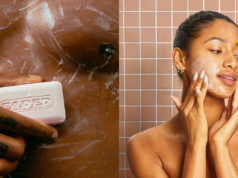How long does waxing last? Not long enough. That’s it. That’s the article. No, but in all seriousness, it’s hard to justify the pain of getting a hair wax, but it’s still a pretty good hair removal option when you compare it to the price of laser hair removal, or the temporary results of a depilatory cream or shaving. Like, once you get past the stinging pain, you’re left with smooth, hairless skin for days. Or is it weeks? A month?!
Depending on who you ask, the question “how long does waxing last?” can have a range of responses, and there’s a reason for that. Here, we’ll get into the hair growth cycle, what happens to the hair follicles when you wax, and how to stretch the time between appointments as long as possible, so keep reading.
There are three phases of hair growth, says Green: (1) Anagen, the active phase of hair growth (when new hair is produced); (2) catagen, the transitional phase (when the hair becomes mature); and (3) telogen, the resting phase (when the hair is ready to shed). Because your hair doesn’t go through the stages of the growth cycle all at the exact same time, the hair will grow back at different rates. After a wax, the hairs that were in the resting phase will begin growing back, and that’s why you’ll see hair regrowth in a matter of weeks but not as thick as before.
On average, a wax will last you three to four weeks. According to Green, the exact amount of time depends on genetics, hormones, certain medications, the area of the body, and honestly, how much hair you can put up with. It also depends on how regularly you wax. If it’s your very first time, it won’t last quite as long as, say, your hundredth (more on that little later).
Each time you remove the hair from the root, you’re damaging the hair follicle, so when it does grow back, Green says the hair will feel softer and finer. Board-certified dermatologist Ellen Marmur previously told Cosmo that when you pull the hair from the root, “eventually, this hair follicle will stop growing hair altogether.” In other words, the longer you continue to remove the root by waxing or sugar waxing, the less the hair will grow back. If your goal is to stop the regrowth, you’ve gotta push through the pain, stay consistent, and you’ll get there.
Waxing appointments are pretty painful and kind of inconvenient to squeeze into your schedule every few weeks, so I get why you might want to prolong that time between waxes, but resist the urge to shave. Gabrielle Ophals of Haven Spa in NYC previously told Cosmo that shaving and trimming in between appointments so you can make your wax last longer won’t do you any favors in the long run because each time you shave instead of wax, you’re reinforcing the strength of that hair at the root. If the goal is to make your waxes last longer, shaving is not the answer.
While you could try a hair growth inhibitor between appointments (Green suggests the EWC Slow Collection), the most effective way to prevent the hair from ever growing back is to stay consistent with your wax appointments and avoid shaving in between them.
Board-certified dermatologist Hadley King, MD, previously told Cosmo that hair should be about one-fourth to three-fourths of an inch long before waxing. The wax won’t be able to get a grip on hair that’s too short, and past a certain point, the longer the hair, the more painful it is to remove. Trim it if it’s longer than three-fourths of an inch to make the process less of an ordeal.
To answer this, you gotta ask yourself a few questions. Do you want something convenient and pain-free? Then shaving is your best option (might we suggest this shave set?). But if you want the hair to grow back softer, thinner, and slower, waxing might be the answer (if you’re not down to try laser). But if you choose to wax, commit to it. IMO the only way the pain would be worth it is to make your wax last as loooong as possible.









